Soft and active matter physics
Welcome to our research page! We are a multidisciplinary team exploring the physics of soft and active materials. Soft matter encompasses a broad class of materials, from everyday plastics to complex biological systems like colloids, polymers, foams, gels, liquid crystals, and biomolecular assemblies. What unites these materials is their remarkable responsiveness to thermal fluctuations: even small perturbations can lead to large-scale structural and mechanical changes. Their rich behavior, spanning many length and time scales, makes them a fertile ground for fundamental and applied research. A key focus of our group is active matter — an emerging field in soft condensed matter physics that challenge our understanding of matter far from equilibrium and hold promise for discovering materials with novel properties. Active systems are made of components that consume energy to move, interact, and self-organize. Think of bacterial colonies, flocks of birds, or self-propelled colloids. These systems defy classical equilibrium physics and give rise to fascinating collective dynamics. We are particularly interested in how particle shape, flexibility, interactions, and internal activity influence the structure, dynamics, and emergent properties of soft and active materials. Our goal is to develop a deeper theoretical and computational understanding that can guide the design of novel materials with tailored functionalities. The research topics explored in our group include:
Physics of active polymers and filaments
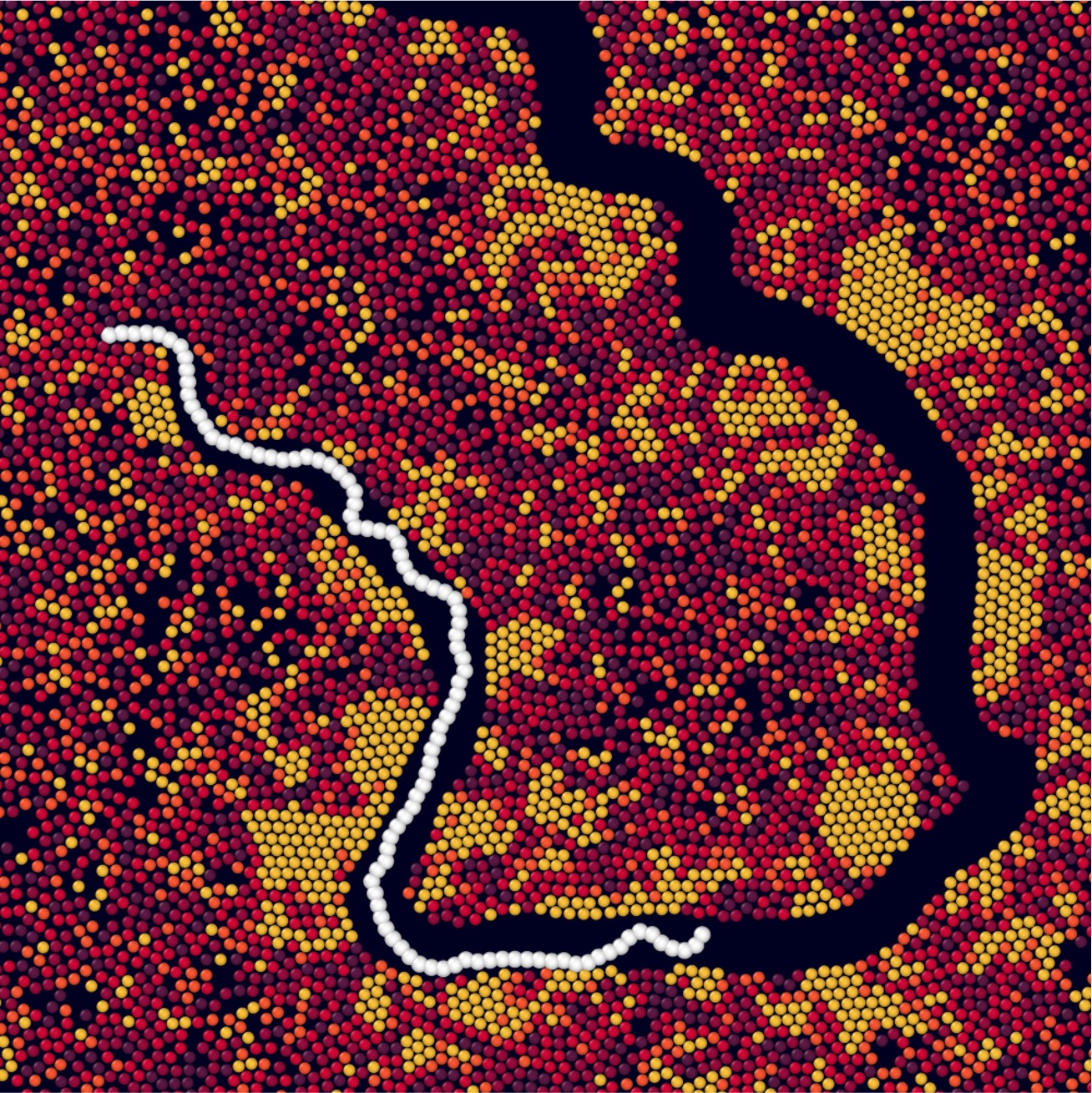
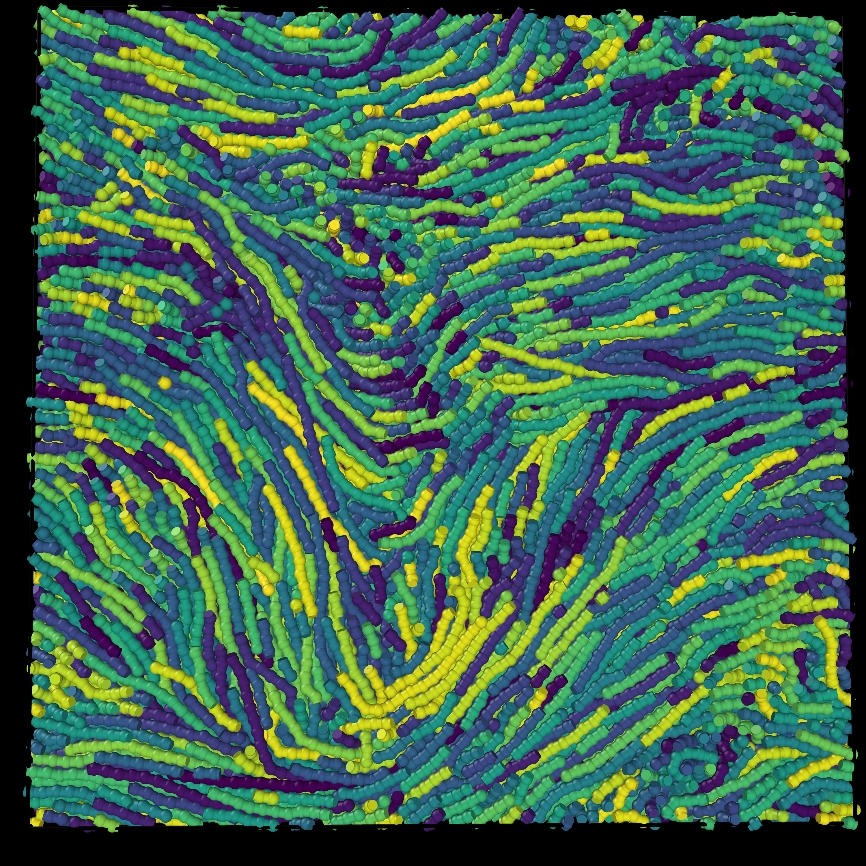 Minimal models—like the Vicsek model of self-propelled particles with alignment interactions—capture some basic features of collective dynamics in active matter, such as bird flocking. However, many real-world active systems involve flexible, deformable units whose internal degrees of freedom are crucial to their collective behavior. Examples include worms, ants, and bio-filaments driven by molecular motors, which can form entangled structures or navigate complex environments—exhibiting dynamics beyond the reach of rigid-body models.
A central focus of our group is to understand emergent phenomena in active polymers and filaments, with particular attention to how flexibility and internal dynamics shape their collective and transport behavior.
We investigate:
Minimal models—like the Vicsek model of self-propelled particles with alignment interactions—capture some basic features of collective dynamics in active matter, such as bird flocking. However, many real-world active systems involve flexible, deformable units whose internal degrees of freedom are crucial to their collective behavior. Examples include worms, ants, and bio-filaments driven by molecular motors, which can form entangled structures or navigate complex environments—exhibiting dynamics beyond the reach of rigid-body models.
A central focus of our group is to understand emergent phenomena in active polymers and filaments, with particular attention to how flexibility and internal dynamics shape their collective and transport behavior.
We investigate:
- Collective dynamics of active semiflexible filaments
- Mechanical properties of active polymeric materials
- Transport and navigation of active filaments in complex environments such as porous or granular media
Collective dynamics of magnetic microswimmers
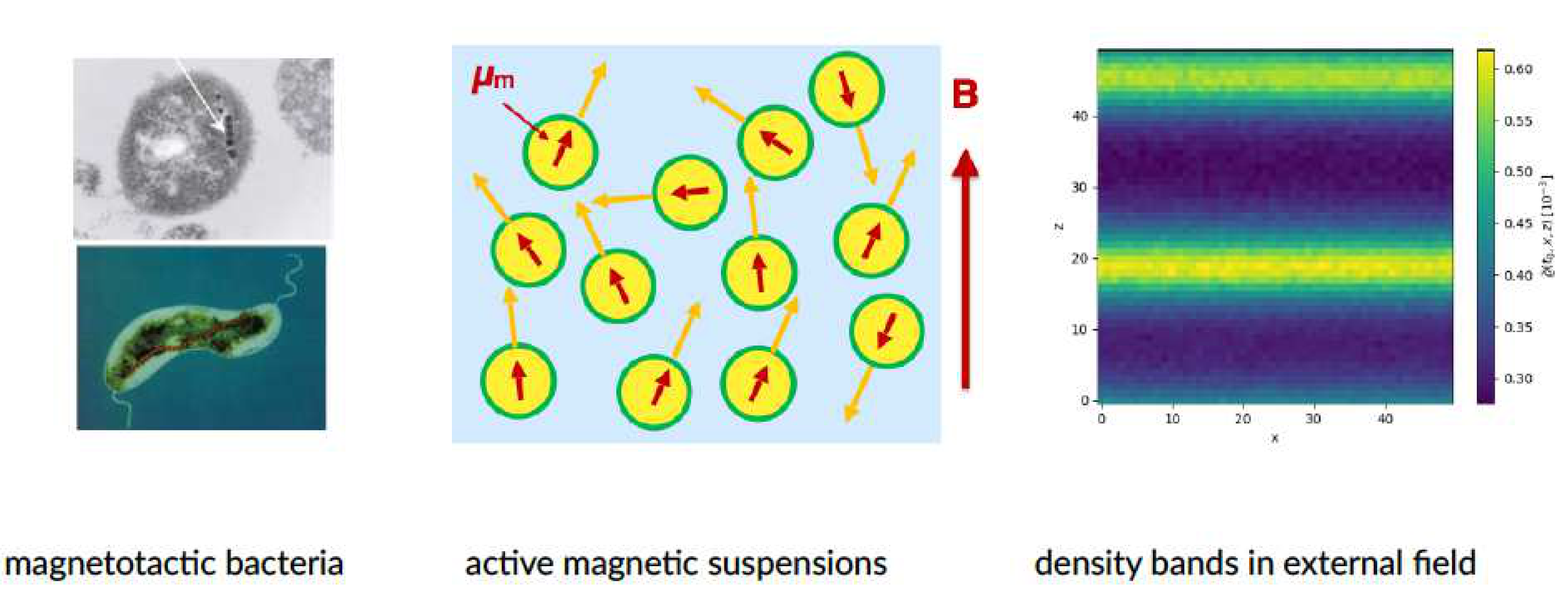 Magnetotactic bacteria are motile organisms with permanent magnetic dipoles that are able to respond to environmental stimuli such as magnetic field and oxygen concentration. The interplay between internal drive (self-propulsion, mutual interactions) and external drive (magnetic field, oxygen gradient) in these systems leads to an emergent collective dynamics. For instance, in an external magnetic field, they form propagating magnetotactic bands on length-scales much larger than the particles size. Inspired by their fascinating collective behaviour, we aim at developing a multiscale description of magnetic self-propelled particle suspensions. Our goal is to link microscopic dynamics of these suspensions with their large-scale effective hydrodynamics. To this end, we employ a minimal model of self-propelled magnetic colloids suspended in a fluid and we combine microscopic dynamic simulations with a mesoscopic kinetic model.
Magnetotactic bacteria are motile organisms with permanent magnetic dipoles that are able to respond to environmental stimuli such as magnetic field and oxygen concentration. The interplay between internal drive (self-propulsion, mutual interactions) and external drive (magnetic field, oxygen gradient) in these systems leads to an emergent collective dynamics. For instance, in an external magnetic field, they form propagating magnetotactic bands on length-scales much larger than the particles size. Inspired by their fascinating collective behaviour, we aim at developing a multiscale description of magnetic self-propelled particle suspensions. Our goal is to link microscopic dynamics of these suspensions with their large-scale effective hydrodynamics. To this end, we employ a minimal model of self-propelled magnetic colloids suspended in a fluid and we combine microscopic dynamic simulations with a mesoscopic kinetic model.
What happens when we pull a polymer?
 Polymeric materials have a wide range of applications from packaging to more high-performance products such as bullet resistant vests and helmets. What makes them attractive for various applications are their special mechanical properties. They deform elastically for relatively large amounts of deformation before they exhibit plastic flow. To understand the underlying mechanisms of plastic deformation in polymeric systems, we employ large scale molecular dynamics simulations of a coarse-grained bead-spring model. By measuring the uniaxial tensile response of amorphous and semicrystalline states of our bead-spring model, we explore the conformational and structural changes of polymers under deformation. If you are interested to know more, you can have a look at articles 21 and 22 in the list of publications.
Polymeric materials have a wide range of applications from packaging to more high-performance products such as bullet resistant vests and helmets. What makes them attractive for various applications are their special mechanical properties. They deform elastically for relatively large amounts of deformation before they exhibit plastic flow. To understand the underlying mechanisms of plastic deformation in polymeric systems, we employ large scale molecular dynamics simulations of a coarse-grained bead-spring model. By measuring the uniaxial tensile response of amorphous and semicrystalline states of our bead-spring model, we explore the conformational and structural changes of polymers under deformation. If you are interested to know more, you can have a look at articles 21 and 22 in the list of publications.
Charged platelets: Liquid crystalline phases or glassy states?
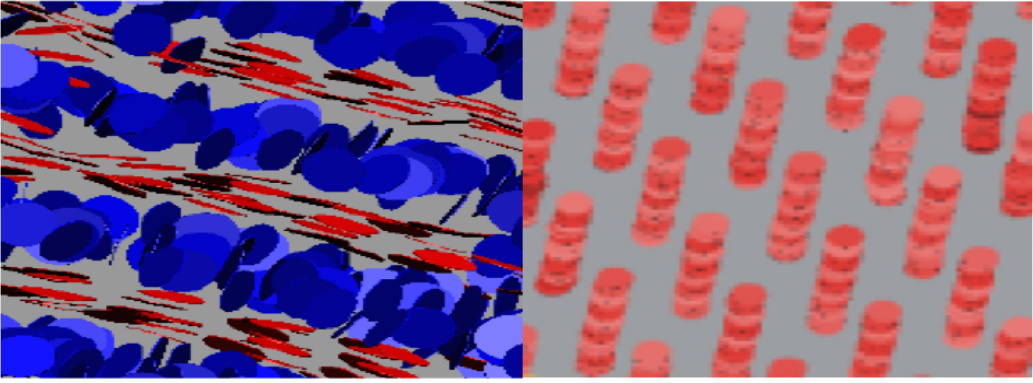 Charged platelet suspensions, such as swelling clays, disc-like mineral crystallites or exfoliated nanosheets are ubiquitous in nature. As a result of interplay between electrostatic and orientation-dependent interactions, they exhibit a complex phase behaviour that is poorly understood. We use Monte-Carlo simulations to characterise the platelets organisation and dynamics. We show that the original intrinsic anisotropy of the repulsive electrostatic potential between charged platelets leads to a fascinating phase behavior which includes variety of glassy and liquid crystalline phases depending on the discs and ions concentration. Our results not only rationalises generic features of the complex phase diagram of charged colloidal platelets but also predicts the existence of novel structures like the structure shown on the left picture. It still remains an open question, how the interplay between attractive and repulsive interactions influences the phase behaviour and dynamics of charged colloidal platelets. If you are interested to know more, you can have a look at articles 19 and 20 in the list of publications.
Charged platelet suspensions, such as swelling clays, disc-like mineral crystallites or exfoliated nanosheets are ubiquitous in nature. As a result of interplay between electrostatic and orientation-dependent interactions, they exhibit a complex phase behaviour that is poorly understood. We use Monte-Carlo simulations to characterise the platelets organisation and dynamics. We show that the original intrinsic anisotropy of the repulsive electrostatic potential between charged platelets leads to a fascinating phase behavior which includes variety of glassy and liquid crystalline phases depending on the discs and ions concentration. Our results not only rationalises generic features of the complex phase diagram of charged colloidal platelets but also predicts the existence of novel structures like the structure shown on the left picture. It still remains an open question, how the interplay between attractive and repulsive interactions influences the phase behaviour and dynamics of charged colloidal platelets. If you are interested to know more, you can have a look at articles 19 and 20 in the list of publications.
Liquid crystals stand between the isotropic liquid phase and the strongly organized solid state. Life stands between complete disorder, which is death and complete rigidity, which is death again.
- Dikran Dervichian
Minimal models for supramolecular self-assembly
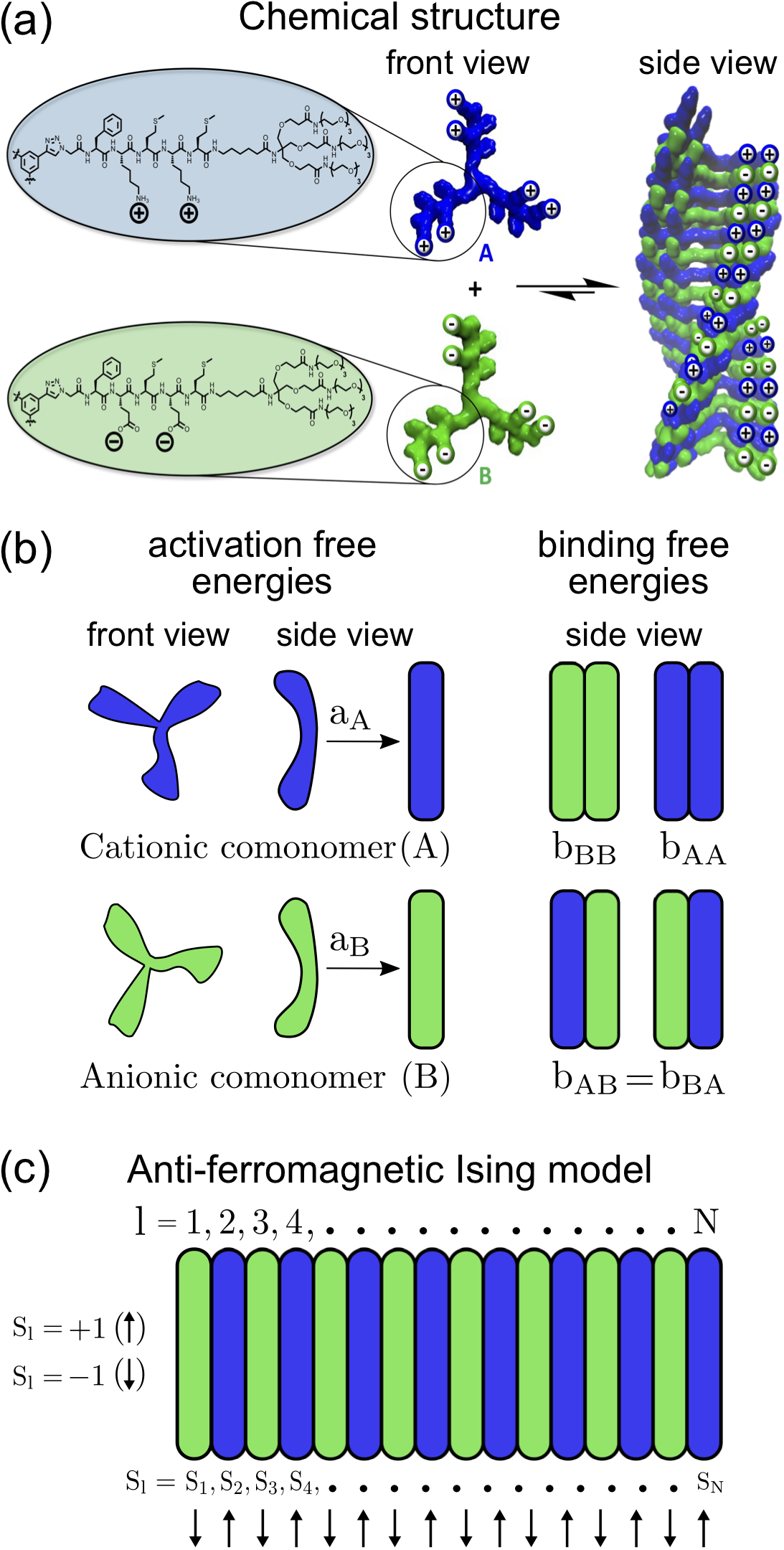
Supramolecular self-assembly refers to structures that are bounded by non-covalent interactions such as hydrogen-bonding. It is ubiquitous in variety of processes in biology and chemistry such as living polymerization of actin and microtubules in the cell. In the past, we have developed statistical physics based model for the description of quasi-linear supramolecular assemblies in two-component systems and self-assembly of guest monomers on DNA-like templates using density functional theory. If you are interested to know more, you can have a look at articles 28, 16, 12 and 10 in my list of publications. Currently, we are interested in modelling the kinetics of self-assembly using appropriate computational models.